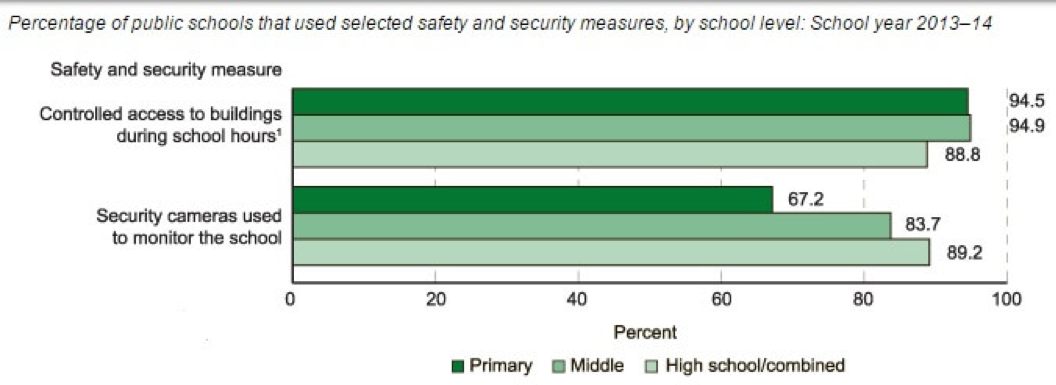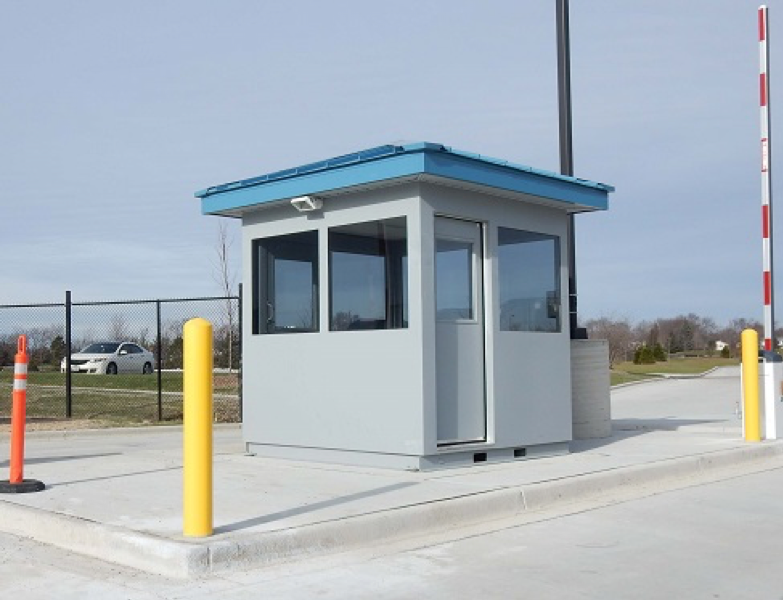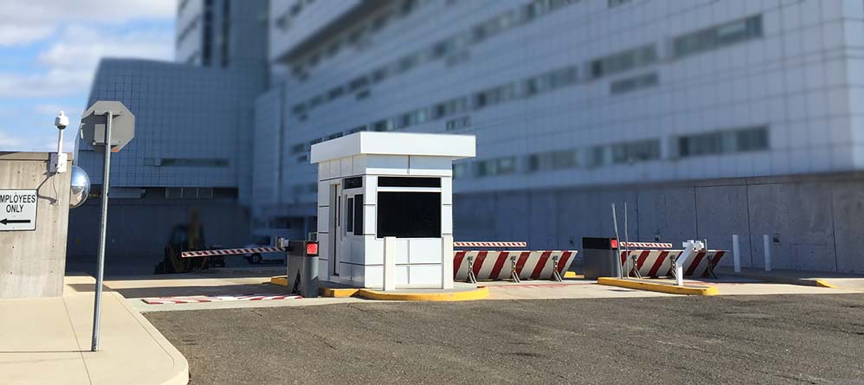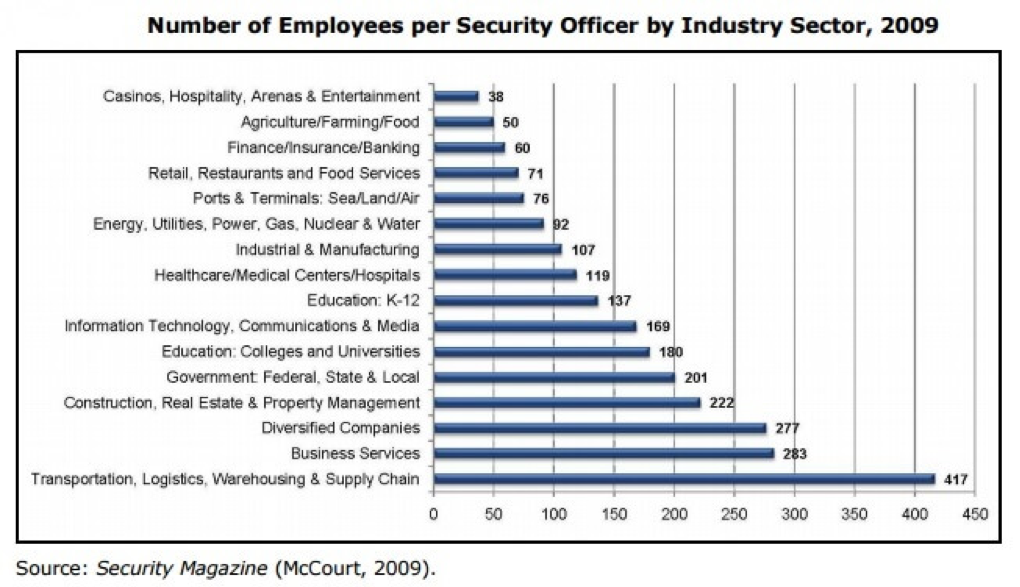Perimeter Security and the Supply Chain Sector
Guest Blog by MHI Member Company, Panel Built, Inc.
With global and public eye concentrating on violence both domestic and abroad, many companies and corporations have looked for a better way to provide protection for their employees and their business as a whole. Certain organizations immediately raise their red flag when security risks arise: airports, government buildings, schools, and hospitals. And their reactions seem very fair and honest. After all, these places typically have a lot of public traffic, high profile people or house sensitive information. However, other industries, for whatever reason, do not seem to quite follow suit…
This chart, pulled from the National Criminal Justice Reference Service, shows the average number of employees per security officer for a number of different industries. As you can see, industries with a lot of public foot traffic (arenas, entertainment, and casinos) “beef up” their security with 1 security officer for every 38 employees. But the companies in the Transportation, Logistics, Warehousing, & Supply Chain sector have 1 security officer for every 417 employees, showing by far the greatest disparity of any industry surveyed. Not only does this leave a minimal amount of security for employees, but also, leaves little protection for all of the valuable inventory and equipment these facilities hold. So, what kind of benefits would these companies see from increasing their facilities’ security? What kind of security systems would they put into place, and how could they do it?
Access Control
In the realm of protection for businesses and corporations, one of the most prominent and probably the most obvious forms of security is physical security. Physical security, as you might have guessed, will typically be anything that protects your facility’s people, property, programs, or data which includes vandalism, theft, and even acts of terrorism. Of these “physical security” measures, one of the most prominent is what is known as “access control.” This practice allows for a facility to control who goes in and goes out of the property. In fact, for school systems, access control is the number one most commonly practiced form of physical security.

Source: National Center for Education Statistics
The main reason access control is such a popular and effective method of physical security is that it allows you to properly log all facility traffic, almost like an accounting department. Every entry into your facility must first be approved then will require a corresponding exit, like credits and debits in an accounting book. As long as your book is balanced at the end of the day, everything is perfect, but if there is an imbalance you will be able to spot it and correct it quickly, thanks to using access control. However, the most important part of access control is being able to actively deny someone access. Facilities that only have a main gate do not necessarily have this ability due to “piggybacking” which occurs when another person slips in while a security gate is open for an authorized person. So what is the best method of controlled access to guarantee no one can slip through the cracks?

1. Perimeter Barrier
For a perimeter barrier, the first thing that comes to mind will be fencing around the facility, however, there are a number of different options available for facilities. There are two main types of barriers that facilities use: passive barriers and active barriers. Fixed barriers act as passive barriers by denying entry to a vehicle, person, or thing. Passive barriers include all of the following: fences, walls, moats, bollards, heavy trees, or even just big rocks. Each of these barriers can accomplish different things. For the majority of them, they do a great job of keeping out all types of traffic (except flying). However, in the instance of bollards, the area allows for the passage of foot traffic, but no vehicles to pass through.
Overall, the main goal of the perimeter barrier is to protect the facility with a limited number of access points to a number that you can easily and actively control. In some cases, a standard fencing could be enough to protect the facility, keeping out potential intruders or animals. But in high threat areas, reinforced walls may be needed to protect against forced entry.
2. Active Barriers
Active barriers are primarily found in a facility’s access control points. Active barriers are usually a type of mechanized gate/entry system that can control the flow of traffic manually or automatically. The main form of active barriers that most people associate with are the pivoting arm gates seen at the entrances of many facilities. These systems are not typically heavy duty, however, will do be adequate for structures like parking decks. The downside is if a vehicle really needs to, it can oftentimes go right through it. For this reason, a variety of “heavy duty” active barriers are offered on the market to prevent this from happening.
For example, crash gates, retracting bollards, retracting wedge barriers, and crash rated drop arms all protect against vehicle ramming and battering. With the some of these active barriers, they can be set to close the entryway automatically (in a fraction of a second) at the approach of a rapid oncoming vehicle, thus preventing unlawful entry.
3. Access Control Point
The access control points of a facility will feature the culmination of your facility’s active barriers and access control system. A well-equipped access point will require guard booth(s), communication devices, a surveillance system, active barriers, instructional signage with directions, and appropriate lighting. For a facility, ideal access control points will keep out unauthorized people and vehicles, while not disrupting the flow of traffic into and out of the facility. In some cases, this will require a facility to have multiple access control points, which can be an appropriate solution (especially if the point is designed for specialty or commercial vehicles), but the higher number of access points, the higher chance of screening failure.
An often-overlooked part of access point design is vehicle approach speed. Even the highest level of perimeter security can fail if a vehicle has enough momentum going through an access point. For this reason, FEMA suggests the use of curved roadways, traffic circles, speed bumps, raised crosswalks, or pavement treatments to reduce vehicle speed ahead of the access point. Additionally, bollards can be used around the guard house to protect it from a major impact. Security alerts can be set up before the entry of the gate to alert guards of oncoming cars moving at a high rate of speed. This would allow for extra time to ensure all active barriers are up and the perimeter is secure by the time the vehicle is intercepted.

Overall, the security of your facility plays a big role in the mindset of employees and their overall safety and well-being. For your business to provide the most effective security system possible, your company will need to take advantage of a number of different security techniques to provide your property with the most effect security system possible. For this reason, careful planning and design of a perimeter security system are vital for ensuring as much protection as possible and a multi-layered security system requires the proper systems to deter, detect, and respond to these incidents. However, with these systems in place and well executed, all employees from the CEO down will be able to work with the peace of mind, knowing that they are protected.






